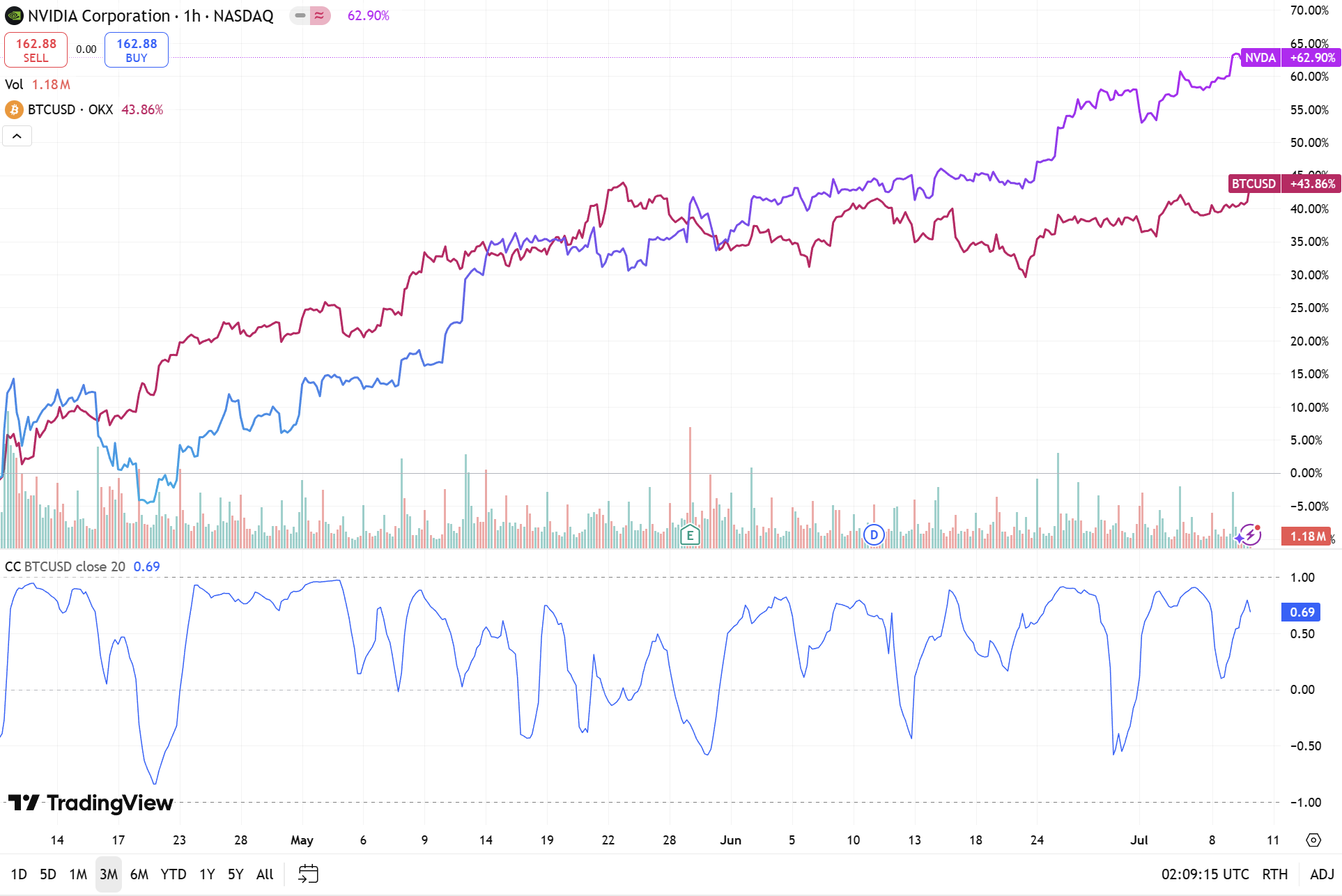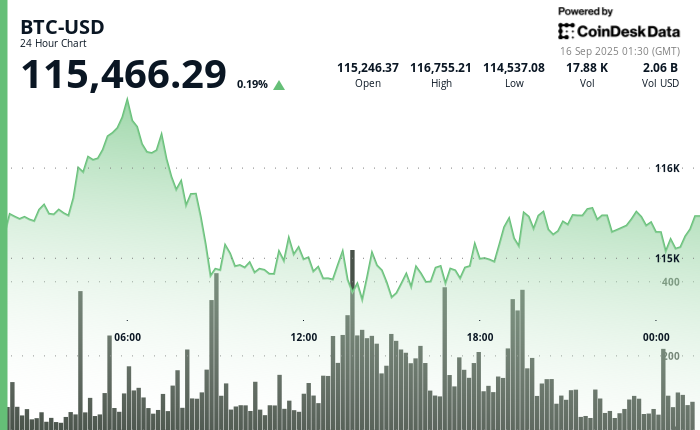Uncategorized
Asia Morning Briefing: Nvidia’s Rally to $4 Trillion Might Have Helped BTC, But Correlation Is Waning

Good Morning, Asia. Here’s what’s making news in the markets:
Welcome to Asia Morning Briefing, a daily summary of top stories during U.S. hours and an overview of market moves and analysis. For a detailed overview of U.S. markets, see CoinDesk’s Crypto Daybook Americas.
Nvidia’s ascent to a historic $4 trillion market cap, the first-ever company to achieve this milestone, might be exactly the catalyst bitcoin (BTC) needed to break out of its tightly coiled trading range and surge toward new all-time highs, addressing analysts’ concerns that the crypto market lacked a clear driver.
BTC is currently trading at $110,900, according to CoinDesk market data, after rallying during the U.S. trading hours to over $111,000 and briefly touching all-time high.
Glassnode analysts had previously described Bitcoin’s recent market activity as quiet, characterized by declining on-chain transactions, minimal miner revenues, and suppressed fees.
Rather than interpreting these factors as bearish indicators, Glassnode highlighted a mature market increasingly dominated by large-value institutional transactions and cautious long-term holders.
All this being said, the correlation between Nvidia and BTC might be short-lived as data suggests its weakening.
While the correlation between the GPU giant and BTC peaked above 0.80 during the AI-driven euphoria of early 2024, and the three-month average remains relatively strong at 0.69, the latest data shows a dip to around 0.36, indicating a possible decoupling as investor focus shifts.
Still, Nvidia’s milestone seemed to serve as a potential trigger for BTC breakout from weeks of price inertia.
However, it’s possible that Nvidia’s share prices might correct at some point, given its volatile nature. But this weakening correlation means that BTC price might remain resilient – when that day comes.

Australia Begins Real-World CBDC Tests
Australia’s central bank digital currency (CBDC) initiative, Project Acacia, has entered its next phase as the Reserve Bank of Australia names 24 industry participants selected to trial real-world applications of digital money in tokenized asset markets.
Spearheaded by the Reserve Bank of Australia and the Digital Finance Cooperative Research Centre, the project brings together major banks, fintechs, and infrastructure firms to trial programmable digital money in real-world financial workflows.
The pilots will explore settlement across asset classes such as bonds, carbon credits, private markets, and trade receivables.
Nineteen projects will involve live transactions, while five will remain at the proof-of-concept stage. ASIC has granted targeted regulatory relief to allow testing with real assets, continuing its approach of enabling responsible innovation in digital finance.
While Australia is pushing ahead with further CBDC development, the Bank of Canada has shifted its focus away from developing a retail CBDC, amid mounting criticism that such a system could enable government surveillance by allowing authorities to monitor every transaction, unlike the anonymity offered by cash.
Market Movements
BTC: Bitcoin hovered near $109,000 as institutions defended key support levels amid light resistance at $110,000, showing resilience despite dormant wallet activity and regulatory uncertainty, while macro conditions such as a weakening dollar and steady rate cut odds bolstered corporate appetite for risk assets, according to the CoinDesk market insights bot.
ETH: ETH closed a volatile 23-hour session up 2.8 percent, with strong institutional volume and resilience above $2,650 signaling continued bullish positioning amid market uncertainty.
Gold: Gold prices extended losses for a second day, hovering near $3,285 as reduced July Fed rate cut bets, a strong U.S. dollar, and firm Treasury yields pressured the metal, though trade tariff concerns and upcoming FOMC minutes helped limit further downside.
Nikkei 225: Asia-Pacific markets opened mixed Thursday as investors weighed the Bank of Korea’s rate hold and U.S. President Trump’s move to impose a 50% tariff on Brazilian imports, citing unfair trade and retaliation over Bolsonaro’s prosecution, with Japan’s Nikkei 225 down 0.45%.
S&P 500: Stock futures were mostly flat Wednesday evening after the S&P 500 clawed back some losses from this week’s tariff-driven decline, with Dow futures slipping just 37 points.
Elsewhere in Crypto
Uncategorized
Asia Morning Briefing: Fragility or Back on Track? BTC Holds the Line at $115K

Good Morning, Asia. Here’s what’s making news in the markets:
Welcome to Asia Morning Briefing, a daily summary of top stories during U.S. hours and an overview of market moves and analysis. For a detailed overview of U.S. markets, see CoinDesk’s Crypto Daybook Americas.
Bitcoin (BTC) traded just above $115k in Asia Tuesday morning, slipping slightly after a strong start to the week.
The modest pullback followed a run of inflows into U.S. spot ETFs and lingering optimism that the Federal Reserve will cut rates next week. The moves left traders divided: is this recovery built on fragile foundations, or is crypto firmly back on track after last week’s CPI-driven jitters?
That debate is playing out across research desks. Glassnode’s weekly pulse emphasizes fragility. While ETF inflows surged nearly 200% last week and futures open interest jumped, the underlying spot market looks weak.
Buying conviction remains shallow, Glassnode writes, funding rates have softened, and profit-taking is on the rise with more than 92% of supply in profit.
Options traders have also scaled back downside hedges, pushing volatility spreads lower, which Glassnode warns leaves the market exposed if risk returns. The core message: ETFs and futures are supporting the rally, but without stronger spot flows, BTC remains vulnerable.
QCP takes the other side.
The Singapore-based desk says crypto is “back on track” after CPI confirmed tariff-led inflation without major surprises. They highlight five consecutive days of sizeable BTC ETF inflows, ETH’s biggest inflow in two weeks, and strength in XRP and SOL even after ETF delays.
Traders, they argue, are interpreting regulatory postponements as inevitability rather than rejection. With the Altcoin Season Index at a 90-day high, QCP sees BTC consolidation above $115k as the launchpad for rotation into higher-beta assets.
The divide underscores how Bitcoin’s current range near $115k–$116k is a battleground. Glassnode calls it fragile optimism; QCP calls it momentum. Which side is right may depend on whether ETF inflows keep offsetting profit-taking in the weeks ahead.

Market Movement
BTC: Bitcoin is consolidating near the $115,000 level as traders square positions ahead of expected U.S. Fed policy moves; institutional demand via spot Bitcoin ETFs is supporting upside
ETH: ETH is trading near $4500 in a key resistance band; gains are being helped by renewed institutional demand, tightening supply (exchange outflows), and positive technical setups.
Gold: Gold continues to hold near record highs, underpinned by expectations of Fed interest rate cuts, inflation risk, and investor demand for safe havens; gains tempered somewhat by profit‑taking and a firmer U.S. dollar
Nikkei 225: Japan’s Nikkei 225 topped 45,000 for the first time Monday, leading Asia-Pacific gains as upbeat U.S.-China trade talks and a TikTok divestment framework lifted sentiment.
S&P 500: The S&P 500 rose 0.5% to close above 6,600 for the first time on Monday as upbeat U.S.-China trade talks and anticipation of a Fed meeting lifted stocks.
Elsewhere in Crypto
Uncategorized
Wall Street Bank Citigroup Sees Ether Falling to $4,300 by Year-End

Wall Street giant Citigroup (C) has launched new ether (ETH) forecasts, calling for $4,300 by year-end, which would be a decline from the current $4,515.
That’s the base case though. The bank’s full assessment is wide enough to drive an army regiment through, with the bull case being $6,400 and the bear case $2,200.
The bank analysts said network activity remains the key driver of ether’s value, but much of the recent growth has been on layer-2s, where value “pass-through” to Ethereum’s base layer is unclear.
Citi assumes just 30% of layer-2 activity contributes to ether’s valuation, putting current prices above its activity-based model, likely due to strong inflows and excitement around tokenization and stablecoins.
A layer 1 network is the base layer, or the underlying infrastructure of a blockchain. Layer 2 refers to a set of off-chain systems or separate blockchains built on top of layer 1s.
Exchange-traded fund (ETF) flows, though smaller than bitcoin’s (BTC), have a bigger price impact per dollar, but Citi expects them to remain limited given ether’s smaller market cap and lower visibility with new investors.
Macro factors are seen adding only modest support. With equities already near the bank’s S&P 500 6,600 target, the analysts do not expect major upside from risk assets.
Read more: Ether Bigger Beneficiary of Digital Asset Treasuries Than Bitcoin or Solana: StanChart
Uncategorized
XLM Sees Heavy Volatility as Institutional Selling Weighs on Price

Stellar’s XLM token endured sharp swings over the past 24 hours, tumbling 3% as institutional selling pressure dominated order books. The asset declined from $0.39 to $0.38 between September 14 at 15:00 and September 15 at 14:00, with trading volumes peaking at 101.32 million—nearly triple its 24-hour average. The heaviest liquidation struck during the morning hours of September 15, when XLM collapsed from $0.395 to $0.376 within two hours, establishing $0.395 as firm resistance while tentative support formed near $0.375.
Despite the broader downtrend, intraday action highlighted moments of resilience. From 13:15 to 14:14 on September 15, XLM staged a brief recovery, jumping from $0.378 to a session high of $0.383 before closing the hour at $0.380. Trading volume surged above 10 million units during this window, with 3.45 million changing hands in a single minute as bulls attempted to push past resistance. While sellers capped momentum, the consolidation zone around $0.380–$0.381 now represents a potential support base.
Market dynamics suggest distribution patterns consistent with institutional profit-taking. The persistent supply overhead has reinforced resistance at $0.395, where repeated rally attempts have failed, while the emergence of support near $0.375 reflects opportunistic buying during liquidation waves. For traders, the $0.375–$0.395 band has become the key battleground that will define near-term direction.

Technical Indicators
- XLM retreated 3% from $0.39 to $0.38 during the previous 24-hours from 14 September 15:00 to 15 September 14:00.
- Trading volume peaked at 101.32 million during the 08:00 hour, nearly triple the 24-hour average of 24.47 million.
- Strong resistance established around $0.395 level during morning selloff.
- Key support emerged near $0.375 where buying interest materialized.
- Price range of $0.019 representing 5% volatility between peak and trough.
- Recovery attempts reached $0.383 by 13:00 before encountering selling pressure.
- Consolidation pattern formed around $0.380-$0.381 zone suggesting new support level.
Disclaimer: Parts of this article were generated with the assistance from AI tools and reviewed by our editorial team to ensure accuracy and adherence to our standards. For more information, see CoinDesk’s full AI Policy.
-

 Business11 месяцев ago
Business11 месяцев ago3 Ways to make your business presentation more relatable
-

 Fashion11 месяцев ago
Fashion11 месяцев agoAccording to Dior Couture, this taboo fashion accessory is back
-

 Entertainment11 месяцев ago
Entertainment11 месяцев ago10 Artists who retired from music and made a comeback
-

 Entertainment11 месяцев ago
Entertainment11 месяцев ago\’Better Call Saul\’ has been renewed for a fourth season
-

 Entertainment11 месяцев ago
Entertainment11 месяцев agoNew Season 8 Walking Dead trailer flashes forward in time
-

 Business11 месяцев ago
Business11 месяцев ago15 Habits that could be hurting your business relationships
-

 Entertainment11 месяцев ago
Entertainment11 месяцев agoMeet Superman\’s grandfather in new trailer for Krypton
-

 Entertainment11 месяцев ago
Entertainment11 месяцев agoDisney\’s live-action Aladdin finally finds its stars





